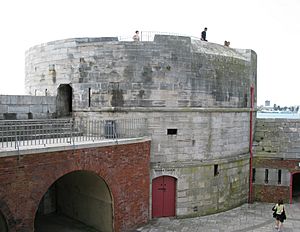List of governors of Portsmouth facts for kids
The Governor of Portsmouth was a very important leader who helped protect the town of Portsmouth in England. For a long time, from the 1200s until the time of King Henry VIII, this role was held by the Constable of Portchester Castle. Later, Portsmouth got its own military leader, called a Captain or Governor. This person was based in the Square Tower, a strong building put up in Old Portsmouth in 1494 to help protect the growing naval port. You can still see the family symbols (Coats of Arms) of past Governors on the walls inside the Square Tower.
Around 1540, a building called the Hospital of St. Nicholas was changed and updated to become the main military center for the town. The part of it known as the Domus Dei, which is now the roofless Royal Garrison Church, became where the Captain or Governor lived. The job of Governor was officially ended in 1834.
The role of Lieutenant Governor was also important. From 1793 to 1968, this position was usually held by a high-ranking army officer in charge of the military forces in the south of England, like the General Officer Commanding Southern District. This job was also eventually ended in 1968.
Contents
Early Leaders: Constables of Portchester Castle and Portsmouth
Before Portsmouth had its own Governor, the town was protected by the Constable of Portchester Castle. These leaders were in charge of the King's castle and the nearby town. They played a key role in defending the area.
Some of the people who held this important position included:
- Richard FitzAlan, 10th Earl of Arundel (in the 1300s)
- John Talbot, 1st Earl of Shrewsbury (in the 1400s)
- Richard Neville, 5th Earl of Salisbury (in the 1400s)
- Anthony Woodville, 2nd Earl Rivers (in the 1400s)
Governors of Portsmouth: Protecting the Port
The Governors of Portsmouth were military leaders responsible for the defense of the town and its vital naval port. They oversaw the fortifications and the soldiers stationed there. This role was crucial as Portsmouth grew into a major base for the Royal Navy.
Many notable figures served as Governor, including:
- Sir Thomas Spert (the first Captain of Portsmouth, starting in 1538)
- William Paulet, 1st Marquess of Winchester (a powerful nobleman in the 1540s)
- Henry Radclyffe, 4th Earl of Sussex (who was both a Warden and Captain in the late 1500s)
- William Herbert, 3rd Earl of Pembroke (in the early 1600s)
- George Goring, 1st Earl of Norwich (who served during the English Civil War)
- Prince James, Duke of York (who later became King James II, in the 1660s)
- Thomas Erle (who served two terms in the early 1700s)
- John Campbell, 2nd Duke of Argyll (a famous general in the 1730s)
- Henry Herbert, 10th Earl of Pembroke (in the late 1700s)
- Prince William Frederick, Duke of Gloucester and Edinburgh (the last Governor, serving until the role was ended in 1834)
Lieutenant-Governors of Portsmouth: Supporting the Defense
The Lieutenant-Governor was the second-in-command, assisting the Governor in managing Portsmouth's defenses. This role was also held by many experienced military officers over the centuries. They played a vital part in the day-to-day running of the garrison and ensuring the town's security.
Some of the Lieutenant-Governors included:
- Sir John Oglander (in the 1620s)
- Sir William Berkeley (in the 1660s)
- Sir John Gibson (who served multiple times around the turn of the 18th century)
- General Peter Campbell (in the 1730s)
- Lieutenant-General Cornelius Cuyler (in the late 1700s)
- Major-General Sir George Prévost (in the early 1800s)
- Major-General Sir James Simpson (in the 1850s)
- General Prince Edward of Saxe-Weimar-Eisenach (in the late 1800s)
- Lieutenant-General Prince Arthur, Duke of Connaught and Strathearn (a son of Queen Victoria, in the 1890s)
Town Majors of Portsmouth: Daily Military Management
The Town Major of Portsmouth was an officer responsible for the daily military administration of the town. This included things like managing the soldiers, keeping records, and ensuring order within the garrison. It was a crucial role for the smooth operation of Portsmouth as a military hub.
Some of the individuals who held this position were:
- Patrick Douglas (the first recorded Town Major in 1753)
- Nathan Ashurst (in the early 1800s)
- Frederick Thomas Maitland (who served in the mid-1800s)


